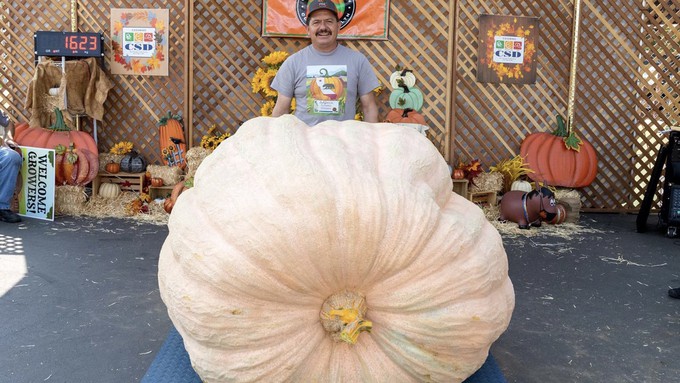
Annual festival celebrates humongous gourds and family fun

Four-time winner Leonardo Urena of Napa poses with his 2021 champion – 1,623 pounds. Photo courtesy of Elk Grove Giant Pumpkin Festival
Where can you see a 1,000-pound pumpkin? Elk Grove, of course, at its annual Giant Pumpkin Festival.
This weekend, Oct. 7 and 8, marks the 29th Giant Pumpkin Festival with plenty of pumpkin to see (and eat!) at Elk Grove Park, 9950 Elk Grove-Florin Road, Elk Grove. Admission is free, but parking is $10 (cash only).
Since 1994, this pumpkin party has grown into the largest salute of its kind in the Sacramento region. Pumpkin growers will haul in their prized giants for the annual weigh-in and a chance at history (as well as cold cash). Last year’s winner (which tipped the scales at 1,866.5 pounds) took home $7,000. The weigh-in starts at 9 a.m. Saturday with winners announced at 4 p.m. Check-in is 7 to 9 a.m.; entry fee is $10 per pumpkin in advance or $25 on Saturday.
Don’t miss the Pumpkin Regatta at noon Sunday. Runner-up pumpkins from the weigh-off are carved into boats and raced across the park’s lake. Anyone (over age 18) with access to a giant floatable pumpkin can enter. Fee is $5 and check-in is 9 a.m. Sunday.
Other contests include a pumpkin recipe contest, cupcake and junior baking contests for kids and teens, a scarecrow contest and youth art contest. (Entry forms and details are available online.)
Expect to find lots of food and fun with food trucks, arts and crafts vendors, carnival rides and, of course, a giant pumpkin patch.
Details and directions: https://www.cosumnescsd.gov/392/Elk-Grove-Giant-Pumpkin-Festival.
Comments
0 comments have been posted.Sacramento Digs Gardening to your inbox.
Sites We Like
Garden Checklist for week of July 21
Your garden needs you!
* Keep your vegetable garden watered, mulched and weeded. Water before 8 a.m. to reduce the chance of fungal infection and to conserve moisture.
* Feed vegetable plants bone meal, rock phosphate or other fertilizers high in phosphate to stimulate more blooms and fruiting. (But wait until daily high temperatures drop out of the 100s.)
* Don’t let tomatoes wilt or dry out completely. Give tomatoes a deep watering two to three times a week.
* Harvest vegetables promptly to encourage plants to produce more. Squash especially tends to grow rapidly in hot weather. Keep an eye on zucchini.
* Pinch back chrysanthemums for bushy plants and more flowers in September.
* Remove spent flowers from roses, daylilies and other bloomers as they finish flowering.
* Pinch off blooms from basil so the plant will grow more leaves.
* Cut back lavender after flowering to promote a second bloom.
* It's not too late to add a splash of color. Plant petunias, snapdragons, zinnias and marigolds.
* From seed, plant corn, pumpkins, radishes, winter squash and sunflowers.